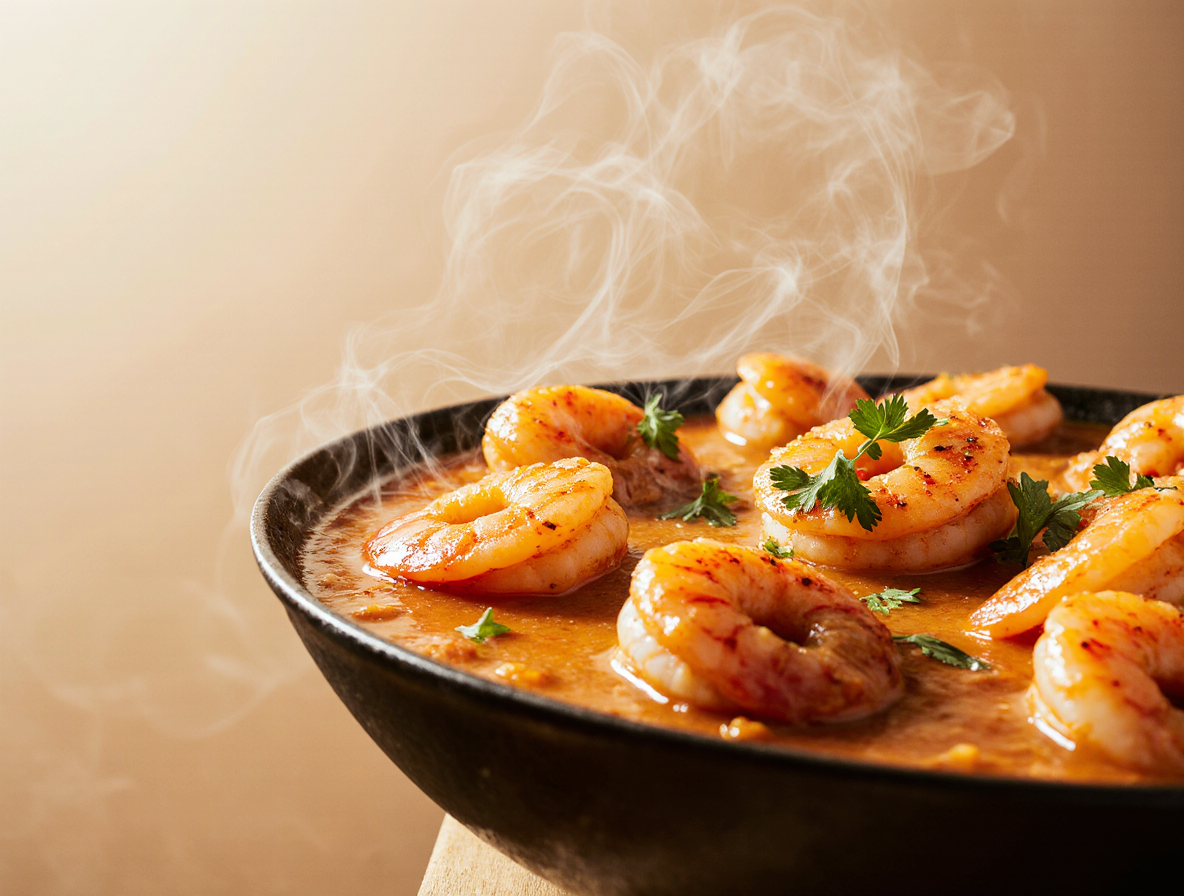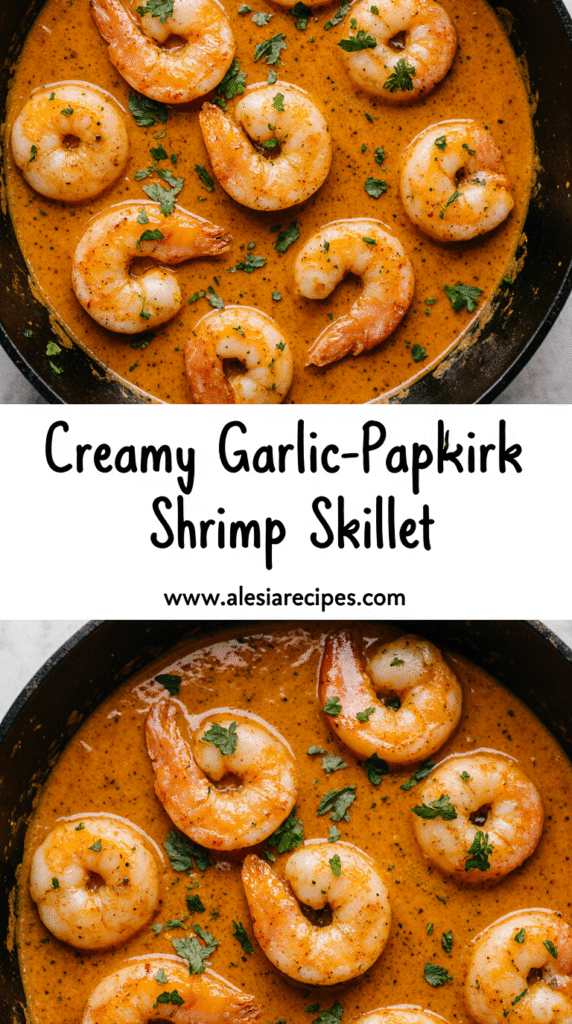How to Make Perfect Paprika Shrimp: A 15-Minute Skillet Recipe
Need a delicious paprika shrimp dinner that’s ready in under 30 minutes? You’re in luck! This creamy garlic-paprika shrimp skillet recipe is the quick weeknight solution we all need in our cooking arsenal.
When life gets hectic, one-pan meals become essential, and this shrimp skillet recipe checks all the boxes. First, it’s incredibly time-efficient, coming together in just 30 minutes[-3][-4]. Additionally, everything cooks in the same skillet, meaning fewer dishes to wash afterward. But the convenience doesn’t sacrifice flavor—this creamy paprika shrimp combines succulent shrimp with a rich, velvety garlic-paprika sauce that’s both comforting and satisfying.
What makes this garlic paprika shrimp skillet particularly special is its versatility. You can easily incorporate late summer vegetables like red bell peppers for a sweet contrast to the paprika sauce, or keep it simple with the core ingredients. Either way, you’ll end up with a high-protein meal that fills you up without weighing you down.
In this guide, we’ll walk you through creating the perfect paprika shrimp from start to finish, including ingredient selection, step-by-step cooking instructions, and delicious pairing options. Let’s get cooking!
Essential Ingredients for Paprika Shrimp
The perfect paprika shrimp starts with selecting the right ingredients. Let’s break down what you’ll need for this flavorful 15-minute dish.
Choosing the right shrimp
For this recipe, medium to large shrimp work best. I recommend using shrimp sized 31-35 per pound or 21-25 count for a more substantial bite. Always start with raw shrimp rather than pre-cooked, as pre-cooked shrimp can quickly become rubbery when heated again. While fresh shrimp is excellent, frozen is perfectly acceptable too—just thaw thoroughly and pat dry before cooking. Furthermore, peeled and deveined shrimp with tails removed will save you valuable prep time, especially for a quick weeknight meal.
Garlic, paprika, and other flavor boosters
Garlic forms the aromatic foundation of this dish—4 to 6 cloves provides the perfect punch. As for paprika, you have options: sweet (classic) paprika complements the mild flavor of shrimp, while smoked paprika adds depth. For seasoning balance, incorporate salt, black pepper, and possibly a pinch of crushed red pepper flakes for heat. Moreover, some recipes benefit from aromatics like finely chopped shallots or onions as a flavor base. For an extra dimension, consider adding ground cumin, which pairs wonderfully with paprika and garlic.
Cream, broth, and tomato paste for the sauce
The creamy sauce requires a few key components. Heavy cream creates that luxurious texture—avoid substituting half-and-half as it can make the sauce too thin. Subsequently, chicken or vegetable broth forms the liquid base; sometimes mixed with a splash of white wine for acidity. Tomato paste is essential—about 1-2 tablespoons amplifies the umami flavor. Allow the tomato paste to cook until it reaches a deep brick-red color to unlock its full flavor potential.
Optional add-ins: spinach, red pepper, lemon
To elevate your paprika shrimp, consider these flavorful additions. Red bell pepper contributes sweetness and a beautiful color contrast[71]. Fresh baby spinach wilts perfectly into the sauce, adding nutrients and vibrant green color. Finally, a squeeze of fresh lemon juice brightens all the flavors. Certainly, these add-ins aren’t just for visual appeal—they transform a simple shrimp dish into a complete one-pan meal.
Step-by-Step Cooking Instructions
Now comes the exciting part—turning those raw ingredients into a mouthwatering meal! Let’s cook our paprika shrimp step by step.
1. Prep and season the shrimp
Pat the shrimp completely dry with paper towels—this crucial step ensures proper searing instead of steaming. In a medium bowl, toss shrimp with sweet paprika, salt, and pepper until evenly coated. For additional flavor, you might add a touch of garlic powder or olive oil to the seasoning mix. Allow the shrimp to rest for 10-15 minutes to absorb the flavors.
2. Sear shrimp in a hot skillet
Heat a large nonstick skillet over medium-high heat until a drop of water sizzles on contact. Add olive oil and butter, then arrange seasoned shrimp in a single layer without overcrowding. Sear undisturbed for approximately 1 minute per side until they begin turning pink and opaque. Once done, immediately remove shrimp to a clean plate—they’ll continue cooking from residual heat.
3. Sauté aromatics and tomato paste
In the same skillet, reduce heat to medium and add diced bell pepper. Sauté for 3 minutes until softened. Next, add minced garlic and cook for 1-2 minutes until fragrant but not browned. Stir in tomato paste and additional smoked paprika, cooking for about 1 minute until the paste darkens slightly—this develops deep flavor.
4. Deglaze and build the sauce
Pour in chicken broth or white wine to deglaze the pan. Use a wooden spoon to scrape up all those flavorful browned bits from the bottom—they’re concentrated flavor bombs! Bring to a simmer and reduce liquid by half. Pour in heavy cream, stir well, and allow the sauce to simmer for 4-5 minutes until it begins to thicken slightly.
5. Return shrimp and finish with lemon and parsley
Gently nestle the seared shrimp back into the sauce and simmer just until heated through—about 1 minute. Off heat, squeeze fresh lemon juice over everything and sprinkle with chopped fresh parsley. Taste and adjust seasonings if needed before serving immediately.
Serving and Pairing Ideas
Once your paprika shrimp is perfectly cooked, the next question is what to serve alongside it. The right pairing can elevate this quick skillet dish from simple to spectacular.
Best sides: rice, pasta, or crusty bread
Rice makes an ideal companion for paprika shrimp, acting as the perfect canvas for that flavorful sauce. Basmati rice offers an aromatic quality that complements the dish beautifully, though jasmine or Japanese short grain varieties work wonderfully too. For something more substantial, orzo provides an interesting texture alternative to traditional rice. Meanwhile, pasta transforms this dish into a complete meal—simply toss your paprika shrimp with angel hair pasta or enjoy it over fettuccine for a more decadent presentation.
Perhaps the most satisfying option, however, is a loaf of crusty bread. Nothing beats using fresh baguette slices to soak up every last drop of that savory, creamy sauce. This simple pairing allows the complex flavors of your garlic paprika shrimp to take center stage.
Low-carb options: cauliflower rice or zucchini noodles
For those monitoring carbohydrate intake, cauliflower rice creates a delicious low-carb alternative. Garlic Parmesan cauliflower rice provides extra flavor that enhances the paprika shrimp without competing with it. Similarly, roasted cauliflower makes a hearty side that complements the dish beautifully.
Another excellent option is zucchini noodles, often called “zoodles.” These vegetable spirals can be topped with your paprika shrimp just as you would pasta. Essentially, they provide the satisfying twirl of spaghetti without the carbs.
Topping ideas: parmesan, chili flakes, or goat cheese
The finishing touches can take your paprika shrimp from good to unforgettable. Consider these additions:
- Freshly grated Parmesan cheese melts slightly into the warm sauce, adding savory depth
- Red pepper flakes provide a welcome heat contrast to the creamy sauce
- Crumbled goat cheese offers tangy creaminess
- Fresh lemon wedges for tableside squeezing
- Chopped fresh herbs like parsley or basil for color and freshness
Regardless of which sides and toppings you choose, paprika shrimp’s versatility means it can be served as an elegant entrée or even as an appetizer, arranged on a platter with toothpicks for easy grabbing.
Storage, Reheating, and Variations
Enjoyed your garlic paprika shrimp dinner but couldn’t finish it all? Let’s tackle proper storage, reheating techniques, and exciting variations to keep this dish versatile.
How to store leftovers properly
To preserve your paprika shrimp’s flavor and texture, allow leftovers to cool to room temperature first (about 30 minutes). Transfer cooled shrimp to an airtight container or resealable plastic bag. Properly refrigerated paprika shrimp stays fresh for 3-4 days. For longer storage, freeze in an airtight container for up to 3 months. During thawing, remember the texture may change slightly although flavor remains intact.
Reheating tips to avoid rubbery shrimp
Overcooked shrimp curls into a tight ‘C’ shape with a dry, rubbery texture. To prevent this, add a splash of broth or water when reheating to maintain moisture. The stovetop method works best—heat a skillet over medium heat with a little olive oil or butter, cooking for just 2-3 minutes until heated through. Alternatively, use the oven at 275°F, covering shrimp loosely with foil to trap steam. Unless absolutely necessary, avoid microwaving as it often makes shrimp rubbery.
Protein swaps: chicken, scallops, or tofu
Not a shrimp fan? This recipe works beautifully with other proteins. Try using chicken or salmon following the same cooking directions. Scallops make an equally delicious alternative. For vegetarian options, simply omit the seafood altogether.
Dairy-free and low-fat alternatives
Create a dairy-free version using plant-based butter as the base for your roux. Replace heavy cream with oat milk or full-fat coconut milk (though coconut may impart a subtle flavor). Many brands now offer heavy whipping cream alternatives specifically designed for cooking.
Conclusion
This paprika shrimp recipe truly stands out as a perfect weeknight solution for busy home cooks. Throughout this guide, we’ve explored how a handful of quality ingredients can transform into a restaurant-worthy meal in just 15 minutes. The combination of succulent shrimp and rich, velvety garlic-paprika sauce creates a dish that feels indulgent yet remains simple to prepare.
What makes this recipe particularly valuable is its incredible versatility. You can easily adapt it to suit your dietary preferences, whether pairing with traditional sides like rice and pasta or choosing low-carb alternatives such as cauliflower rice and zucchini noodles. Additionally, the protein can be swapped for chicken, scallops, or even tofu while maintaining the dish’s delicious flavor profile.
The one-skillet approach means cleanup remains minimal, making this dish practical for everyday cooking. Certainly, the techniques we’ve covered—from properly searing shrimp to building a flavorful sauce—can be applied to countless other quick meals in your cooking repertoire.
We hope you’ll try this paprika shrimp recipe the next time you need a quick yet impressive meal. The balance of speed, simplicity, and fantastic flavor makes it a recipe worth returning to again and again. After all, dishes that combine convenience with gourmet results deserve a permanent place in your cooking arsenal.
FAQs
Q1. What’s the best way to season shrimp for this recipe? For this paprika shrimp recipe, combine sweet paprika, salt, and pepper in a bowl. Toss the shrimp in this mixture, allowing them to marinate for 10-15 minutes to absorb the flavors. You can also add a touch of garlic powder or olive oil for extra flavor.
Q2. How do I prevent overcooking the shrimp? To avoid overcooking, sear the shrimp for about 1 minute per side in a hot skillet until they begin to turn pink and opaque. Remove them from the pan immediately and set aside. When you return them to the sauce later, only heat them through for about a minute to ensure they stay tender and juicy.
Q3. Can I use other proteins instead of shrimp in this recipe? Absolutely! This recipe is versatile and works well with other proteins. You can substitute the shrimp with chicken, salmon, or scallops using the same cooking method. For a vegetarian option, you can omit the seafood altogether or use tofu as an alternative.
Q4. What are some good side dishes to serve with paprika shrimp? Paprika shrimp pairs well with various sides. Rice (basmati, jasmine, or short-grain) and pasta (angel hair or fettuccine) are excellent choices. For low-carb options, try cauliflower rice or zucchini noodles. A crusty bread is perfect for soaking up the delicious sauce. You can also add toppings like Parmesan cheese, chili flakes, or fresh herbs for extra flavor.
Q5. How should I store and reheat leftovers? Allow the paprika shrimp to cool to room temperature, then store in an airtight container in the refrigerator for up to 3-4 days. When reheating, add a splash of broth or water to maintain moisture. The best method is to reheat gently on the stovetop for 2-3 minutes until just heated through. Avoid microwaving as it can make the shrimp rubbery.


